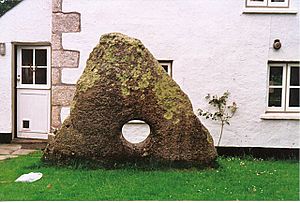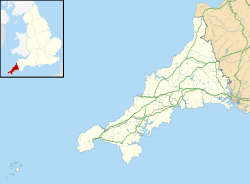Tolvan holed stone facts for kids

Tolvan holed stone
|
|
| Region | Cornwall |
|---|---|
| Coordinates | 50°06′18″N 5°12′32″W / 50.105121°N 5.209012°W |
| Type | Holed stone |
| Official name | Tolvan Holed stone |
| Designated | 1923 |
| Reference no. | 427073 |
The Tolvan holed stone is a very old, triangular-shaped stone from the Neolithic period. This means it was made a long, long time ago, when people first started farming. It's a type of standing stone, which is a large stone placed upright by people.
This amazing stone is about 2.3 meters (or about 7.5 feet) tall. It has a big, round hole near its bottom, which is about 43 centimeters (or 17 inches) wide. You can find this ancient stone in a garden near the village of Gweek in Cornwall, England. It's special because it's the biggest holed stone of its kind in Cornwall!
Contents
What Does the Tolvan Stone Look Like?
The Tolvan holed stone is a huge stone shaped like a triangle. It stands tall at 2.3 meters (about 7.5 feet). At its widest part, near the bottom, it measures 2.3 meters across. The stone is also about 0.3 meters (or 1 foot) thick.
The most interesting part is the circular hole near its base. This hole is about 43 centimeters (17 inches) in diameter. The stone is located about 800 meters north of Gweek, behind a farmhouse. It wasn't always in this exact spot. It was moved here in 1847. Later, a small house was built next to it. The Tolvan stone is the largest holed stone you'll find in Cornwall.
History of Holed Stones
Holed stones like the Tolvan stone are quite rare. They come from the Neolithic period, which was a time when early humans began to settle down and farm. Experts believe these large standing stones were once part of bigger stone structures. They might have been used as entrances to ancient burial places called portal dolmens.
These types of standing stones were likely built between 3500 and 2600 BC. In Britain, there are at least 20 portal dolmens, and most of them are found in west Cornwall.
The Name and Its Journey
The name "Tolvan" comes from "Tol-vean," which means "holed stone." People have known about the Tolvan holed stone for a long time. It was first mentioned in records in Cornwall in 1649, where it was called the "Main-toll great stone."
The stone was moved from its original spot to where it is now in 1847. Back then, it was even bigger, about 2.6 meters tall and 2.7 meters wide. But it had to be made a bit smaller to fit through gateposts when it was moved!
What Was Found Nearby?
Before 1864, something interesting was found at the stone's original location. There was a circular pit, about 1.5 meters wide, lined with stones and covered by a large slab. Inside this pit, people found quartz stones and pieces of pottery.
Historians at the time thought this pit was an ancient grave. They believed the holed stone was part of an old dolmen, which is a type of tomb. Next to this pit, there was also a trough-shaped stone called the "Cradle," but it was later destroyed.
Ancient Beliefs and Traditions
In 1885, people recorded a local tradition about the Tolvan stone. Some believed that if sick children were passed through the hole in the stone, it could help cure their illness. This shows how important and special these ancient stones were to the people who lived near them.


